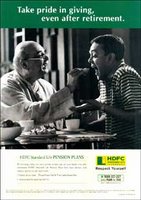Brand : ING Vysya Life Insurance ( IVL)
Company : ING Vysya
Agency : Rediffusion Dy&R
Brand Analysis Count : 316
In most cases, we discuss branding in relation to products rather than services. Some how there is a feeling that unlike products , building brands through promotions lacks significa

nce in the marketing of services. Usually service brands are built on functional dimensions rather than on imagery.
Hence it is taken for granted that if the service provider delivers excellent functional performance , the brand will automatically grow.Five years back , financial service firms focused on their sales force and below -the- line promotion and shied away from aggressive brand building through advertising.
But the increase in competition and the cut-throat warfare on the field forced the service firms to venture into aggressive brand building through advertising.This trend was initiated by the aggressive brand promotion by telecom service providers. Financial services firms began to realize that having a good brand will make the life of a salesperson a lot easier.
The latest aggressive candidate in the financial services branding is ING Vysya Life Insurance ( IVL ) . IVL launched its insurance services in 2001. Now it has grown into size with presence in 246 cities and 300 odd branches.
What has interested me is the current campaign run by IVL. The brand did not have a good run in the Indian market. According to media reports, the IVL has a market share of only 1.2 %. The primary reason being that the strategy of the company is slow and steady growth rather than aggressive growth. So very rarely you get a call from an ING Vysya Insurance advisor.
The brand first launched its campaign in 2007 when it identified the core brand value. ING Vysya Life Insurance decided that the brand stands with the consumer in helping him fulfill his responsibilities towards themselves and families. Thus IVL took up the slogan " Mera Farz " which means " My Responsibilities ".
Watch the campaign here :
Mera Farz 1The ad was well made but nothing special in terms of creativity and was not intended to deliver any result on the field. But this gave the brand a vital direction for the future.
This year, IVL came out with another set of campaign which captured the attention of the audience .
The new campaign took birth from a very important consumer insight that with every happy moments , comes certain burden of responsibilities " . The thought of these additional burden creates a " Sinking Feeling " in the mind of that person and it will take away some degree of joy from him.
From this insight came this campaign :
Sinking FeelingThe ad show three situations
1. Marriage
2. Birth of a child
2. Daughter getting admission to a expensive college.
The protagonist in all these cases feels a sense of sinking with the burden of added responsibilities.
What I noticed from the reaction of my family members is that the idea has clicked. There was a little smile in everyone's face when they saw this ad.
There is no doubt that the idea is a BIG Idea but the execution was a little too straight. Personally speaking , I did not liked the term " BURDEN " . In Hindi the term used is "Bhari" and in Malayalam the term used is "Bharam"- both these terms are used to denote Burden and also heaviness.
When my child was born, I never felt it as burden but it is true that there was added responsibility but never a burden. Even the child's education to be termed as a burden is too harsh . It was not the visuals but the term " Burden " that I disliked about the ad.
The message behind the campaign is that ING Vysya's plans help you to experience the joy of responsibility.
Then came another ad which I thoroughly enjoyed.
Watch the ad here :
ING GoaThe ad shows the husband Satheesh literally sinking into the floor when his wife tells the friends about 'their ' plan to buy a house in Goa. Even after seeing the ad many times, we all still liked the look of the harassed " Satheesh " . That was a wonderful execution.
The big idea of ' Sinking Feeling ' has the potential to last for some time because it stems from an actual consumer insight.
These campaign has brought the customer's attention on this brand. The insurance advisors now will have a chance to spent less time talking about the company and more time selling the plans

















